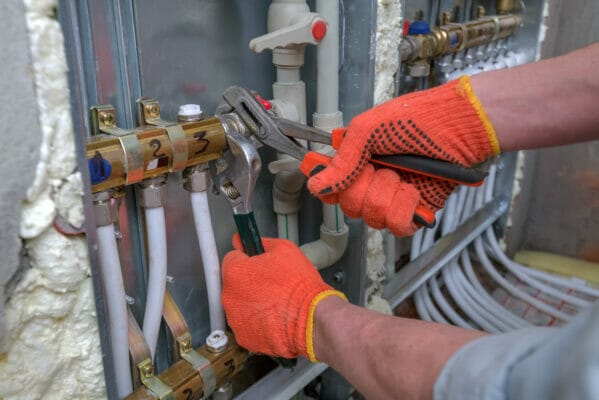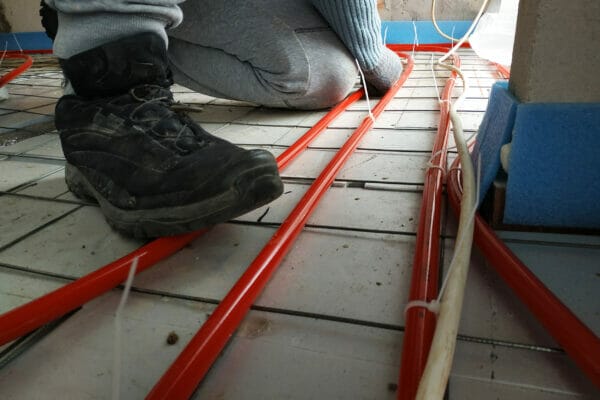Disclaimer: This post may contain affiliate links, meaning we get a small commission if you make a purchase through our links, at no cost to you. For more information, please visit our Disclaimer Page.
Pipefitting can be a time-consuming and physically demanding job. Fortunately, today, unlike in previous generations, the development of power tools and lightweight pipe materials has made the job easier. You can now drill, cut, and lift all the building material and join the pipes easily.

However, pipefitting requires heavy and hard work, and you should be comfortable working with heights or under intense pressure as emergencies like gas and oil leaks are often involved.
Pipefitters might experience fluctuating working hours in which you may be forced to work both day and night. You may also have to work from hostile working environments, including the oceans and seas.
Table of Contents
How Long Does It Take to Be a Pipefitter?
Pipefitters require apprenticeships that will typically take about 4-5 years to complete. Apprenticeship programs are offered by businesses, trade associations, and unions.
Apprentices often receive 2,000 hours of paid on-the-job training under experienced pipefitters and some class technical inclusion instructions. Asking questions and paying attention is an excellent way to learn.
The apprenticeship training programs are created to introduce pipefitters to blueprinting reading, safety codes, and regulations. Moreover, a pipefitter can learn all the necessary skills, including grinding, threading, soldering, welding, and working with metal and pipes in general.
A high school diploma or equivalent may be required to become a pipefitter. You may also need to complete courses on safety, pipe system design, and tool use.
A welding course could be necessary by some pipefitter apprenticeship training programs. Moreover, pipefitters apprentices should study applied physics, chemistry, and mathematics.
What Kind of Math Should Pipefitter Know?
Geometry and algebra are incredibly vital when it comes to the job layout. Besides, basic math also comes in handy as the job requires measuring. For instance, the 45-degree formula is crucial for every pipefitter to connect two pieces of pipes.
Is It Hard to Understand the Blueprints in Pipefitting?
Following plumbing designs and rules for correct pipe placement and connection is an essential element of pipefitting. As a result, pipefitters must be able to read and comprehend designs.
Practical training in vocational programs might help you quickly grasp the concepts.
This allows you to look at the work designs and figure out how to install a certain pipe system that will not leak. Understanding the processes also promotes safety when doing installation, maintenance, and testing.
What Are the Necessary Skills for Pipefitters?
Communication skills are essential to ensure you communicate crucial details about the job to customers using layman’s language.
You should be able to say what’s happening and why. You should also have the skills to handle parts and tools with precision, even when working in very tight places.
Furthermore, a pipefitter should have troubleshooting skills to ensure you can diagnose and repair issues. It would help if you were comfortable setting up and testing new piping systems. Besides, a pipefitter should have skills in cutting and welding methods.
Is Being a Pipefitter Hard on Your Body?
As a pipefitter, you need to be able to lift at least 40-50 pounds. But in most cases, you’ll have access to lifting machinery to remove a portion of the strength requirement. While starting, you might have someone to help you, and as you continue working, you’ll likely become stronger, and the fitting job will become easier.
However, there are physical demands for pipefitting, including:
- Walk, run, or stand for long periods
- Use your hands to control, handle, or feel tools, objects, or controls
- Twist or bend your body
- Repeat similar movements
- Kneel, crouch, stoop, or crawl
- Climb ladders, poles, or scaffolds
Is Being a Pipefitter Stressful?
Being a pipefitter can be stressful. You’ll be dealing with anxious scenarios like water pouring through ceilings or pipes bursting in subzero temperatures.
Moreover, pipefitters are lifelong learners as you’ll often encounter new challenges and need to find new ways to put your skills to use.

Is Being a Pipefitter Dangerous?
You could be working with dangerous chemicals and raw sewage at times. These materials expose pipefitters to a variety of injuries.
The usage of combustible items also raises the danger of fires, which can result in smoke inhalation and burns. Chemical fumes can damage the respiratory tract, while splashes can cause skin burns or eye injuries.
According to the United States BLS, pipefitters have one of the highest workplace rates of injury and illness of any occupation.
Some of the injuries a pipefitter could suffer include cuts and lacerations, amputations, vision loss, a broken bone, hearing loss, traumatic brain injuries, paralysis, neck, back, and shoulder injuries.
Do Pipefitters Require Licensing?
Most local authorities and states require pipefitters to be licensed. While the licensing requirements may vary, many states require the fitter to have at least 2 to 5 years of experience and pass an exam.
The exam demonstrates your knowledge of the trade and local pipefitting codes before you’re permitted to work as a pipefitter.
Besides that, many employers require pipefitters to have a driver’s license. Finally, note that those pipefitters who want to work at gas stations are required to acquire a special permit that tests gas-related work experience and safety codes.
Is Pipefitting a Good Career?
With an interest and the right attitude, a pipefitting career can offer a deal of long-term job satisfaction. While the job can be dangerous, it’s rewarding both personally and financially. In fact, pipe fitting is amongst the highest paid of the trades.
According to the US Bureau of Labor Statistics, the median wage for pipefitters is $52,590 annually or $25.28 per hour. The top ten percentile of pipefitters earns over $91,810 annually. Besides, a pipefitting career isn’t too difficult to join.
For instance, it only requires work-related or apprenticeship skills and knowledge.
What Do Pipefitters Do Exactly?
A pipefitter is a tradesperson who installs, fabricates, assembles, repairs, and maintains mechanical piping systems. The piping systems can include ventilation, steam, chemicals, hydraulics, oil, and fuel.
So, essentially, they’re specialized plumbers who install and maintain pipes carrying gases, water, and acids. Typically, pipefitters work in power plants, factories, oil refineries, or heating and cooling systems in large buildings.
Note that some pipefitters specialize as sprinkler-fitters, steamfitters, or gasfitters. Income for each job varies, however it’s good to diversify if your work is seasonal.
Moreover, a pipefitter attaches pipes to structures, walls, and fixtures like tanks or radiators, using clamps, tools, brackets, or welding equipment.
They also measure and mark pipes for threading, cutting, and welding using specific tools like cutting torches, saws, benders, pipe threaders and welders.
Is It Difficult to Find a Pipefitter Job?
As the industry grows, the demand for pipefitters is increasing exponentially. The projected percentage change in pipefitter employment is expected to rise by 16% from 2016 to 2026, that’s much higher than the average growth rate for all occupations, at 7%.
The top industries for pipefitters include utility system construction, nonresidential building construction, natural gas distribution, and local government. Pipefitters also work in the building equipment contractors’ industry.
Are All Pipefitters Welders?
Pipefitting may require a few welding skills but doesn’t necessarily need to perform all the welds that welders do. In most pipefitting jobs, you’ll be required to focus solely on laying and threading pipe, and the welders will connect the components of the pipes.
However, a pipefitter should be able to work with others and take charge of any situation since you’ll typically be the most informed on a project.
